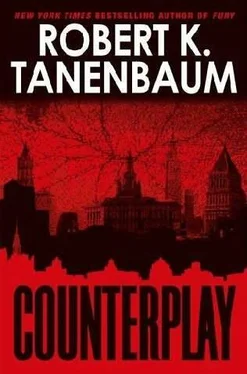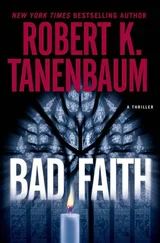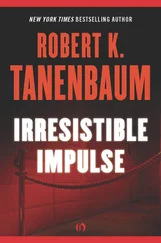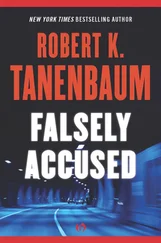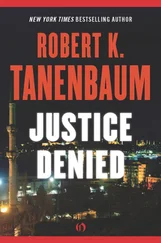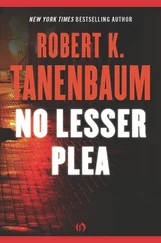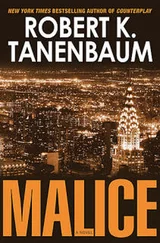Robert Tanenbaum - Counterplay
Здесь есть возможность читать онлайн «Robert Tanenbaum - Counterplay» весь текст электронной книги совершенно бесплатно (целиком полную версию без сокращений). В некоторых случаях можно слушать аудио, скачать через торрент в формате fb2 и присутствует краткое содержание. Жанр: Криминальный детектив, на английском языке. Описание произведения, (предисловие) а так же отзывы посетителей доступны на портале библиотеки ЛибКат.
- Название:Counterplay
- Автор:
- Жанр:
- Год:неизвестен
- ISBN:нет данных
- Рейтинг книги:4 / 5. Голосов: 1
-
Избранное:Добавить в избранное
- Отзывы:
-
Ваша оценка:
- 80
- 1
- 2
- 3
- 4
- 5
Counterplay: краткое содержание, описание и аннотация
Предлагаем к чтению аннотацию, описание, краткое содержание или предисловие (зависит от того, что написал сам автор книги «Counterplay»). Если вы не нашли необходимую информацию о книге — напишите в комментариях, мы постараемся отыскать её.
Counterplay — читать онлайн бесплатно полную книгу (весь текст) целиком
Ниже представлен текст книги, разбитый по страницам. Система сохранения места последней прочитанной страницы, позволяет с удобством читать онлайн бесплатно книгу «Counterplay», без необходимости каждый раз заново искать на чём Вы остановились. Поставьте закладку, и сможете в любой момент перейти на страницу, на которой закончили чтение.
Интервал:
Закладка:
“I suppose it is possible but we-”
“Is ‘I suppose,’ a ‘yes,’ Dr. Swanburg?”
“Yes, a qualified yes, but a yes.”
“More like a qualified guess, Dr. Swanburg.”
Swanburg looked somewhat bemused but let the aside go without comment.
“Let’s move on, Dr. Swanburg,” Anderson said. “Essentially, what you told Mr. Guma is that the standard accepted methods of human identification were not available to you.”
“Well, no, that’s not what I said at all,” Swanburg replied. “I testified that two methods-granted, the most common known to laypersons such as you-were not available to us. And I’ll concede that these other methods are less exact, but I believe that my colleague will be testifying that these other methods have been used in courts throughout the world for years now.”
When Swanburg stepped down, Karp called Charlotte Gates to the stand. After the exchange of pleasantries and establishing her expertise, he began by asking her for a short version of the excavation process. When she finished, he noted Swanburg’s testimony regarding the lack of fingerprint or DNA evidence. “Does that mean we have no other scientific means of identifying these remains?”
“Not at all,” Gates replied. “Those are just two.”
“Would you care to elaborate?”
“Sure. For one thing, even though we don’t have dental records, the deceased’s teeth can still give us clues to her identity.”
“How so?”
“Well, through a subspecialty of dentistry called forensic odontology, something I’ve studied in my practice as a forensic anthropologist. There are several reasons why the dentition is valuable for human identification. Tooth enamel is the hardest substance in the human body, which makes teeth capable of surviving conditions under which other human tissues, including bone, deteriorate. Dental work such as fillings, crowns, bridges, and root canal therapy are individually customized for each patient; plus, individuals lose or damage teeth, as well as the bone that holds them. It is these unique qualities that enable forensic odontologists to compare dental restoration work, through X-rays or even anecdotal evidence, with the remains to identify, or exclude, a possible missing individual with a very high level of probability. However, as you’ve heard in this case, there are no dental records for comparison.”
“And so?”
“And so we move on to a less exact but nevertheless valid means to ‘narrow the field,’ so to speak,” Dr. Gates said. “We all know that we lose our so-called baby teeth at certain points in our life-give or take a year or two. But actually, we can make determinations as to age well into adulthood because dental development is tightly controlled and protected against disturbances through a process known as canalization. The disadvantage of age estimates, based on dental development, is that most adults have completed the process by age twenty-five.”
“So from what you just said,” Karp asked, breaking up the sequence to make it more understandable, “what can we say about the remains found in the defendant’s backyard?”
“We can say the deceased was at least twenty-five years old,” Gates replied.
“Can you be any more exact?” Karp said.
“To a lesser but still scientifically valid degree I can,” Gates said. “As strong as they are, our teeth don’t last forever. We wear them down by eating hard foods and grinding them against each other. We also tend to lose some of the bone around the roots as we grow older, and we experience more gum diseases, some of which can be seen in the bone of the jaw as well as the teeth themselves.”
“Well, do all people wear out their teeth at the same rate?” Karp asked.
Gates shook her head. “No, and as a matter of fact that can vary greatly according to culture, socioeconomic status-i.e., such as the availability and frequency of dentist visits-and some physical cause, such as a tense person who grinds their teeth a lot. However, a fairly large body of evidence has been gathered comparing thousands of people-both living and deceased-in any one age, gender, social class, and area. The end result is the ability to say that the average person in a certain category can be expected to demonstrate particular aspects in regard to their dentition. For instance, the teeth of the average wealthy white male in the United States will look different at age fifty, than the teeth of the average impoverished Asian, fifty-year-old female in Cambodia.”
“So using this comparison system, can you estimate the age of the remains in question?” Karp asked.
“Yes, these comparison studies have been fed into computers, which I’ve accessed,” Gates replied. “The remains fall into the category of adult, Caucasian females of upper-middle to wealthy economic status with an age range of between thirty and forty-two years.”
“And do you recall the age of Teresa Stavros when she disappeared?”
“I’ve been told that she was thirty-five years old.”
“That’s correct,” Karp nodded. “Is there anything else that might indicate the age of the victim in this case?”
“Objection,” Anderson said. “There’s no foundation that the remains are those of a crime victim.”
“I see,” Karp said. “Then perhaps we should call the Smithsonian Institution to let them know that we may have discovered the ancient burial grounds of Pocahontas-she having died of natural causes.”
Anderson chuckled and shook his head as if greatly amused while pouring himself a drink of water. The rest of the courtroom laughed as well.
“Let me rephrase that,” Karp said, smiling. “Is there anything else you can tell us about the age of the person whose remains just happened to wind up in the backyard of Emil Stavros?”
“Yes,” Gates nodded. “When we’re young our bones are very flexible because they have not hardened. This process begins at the growth places on either end of the bone and works its way toward the center until they meet and we have the stronger but more brittle bones of an adult. Bones can tell a story if you know how to read them. For instance, in adulthood we can see where someone broke his leg as a child. But there are more subtle clues as well, such as the onset of age-related arthritis. Or, in the case of women especially, who have difficulty maintaining bone density as they age due to a lack of calcium, the onset of osteoporosis.”
“And how does that help you determine age?” Karp asked.
“In a way that is similar to the comparison studies of teeth,” Gates replied. “By comparing the bones of thousands of females whose age at death was known, we can say with a strong degree of scientific certainty that the remains we exhumed belonged to a woman in her midthirties to early forties.”
Karp took a sip of water from a cup on the prosecution table and looked at Emil Stavros, who quickly let his attention be drawn to his notepad. “Now, Dr. Gates, a moment ago you said that the remains belonged to a woman. Was it possible to establish the gender by looking at the bones?”
“Yes, there are several means,” Gates said. “The easiest was looking at the bones of the hips. I’m sure we’re all fairly aware that a woman’s hips are anatomically different from a man’s, in large part so that a woman can give birth.”
“Speaking of hips, Dr. Gates,” Karp said, “is there something more you can tell from the hip bones found in the grave?”
“Yes, she’d given birth to one, perhaps, two children,” Gates said. “Babies do not pass through the birth canal easily, and the pressures of childbirth cause the bones to move and scar.”
“So in summation, what can you tell us to a reasonable degree of scientific certainty about the remains?”
Читать дальшеИнтервал:
Закладка:
Похожие книги на «Counterplay»
Представляем Вашему вниманию похожие книги на «Counterplay» списком для выбора. Мы отобрали схожую по названию и смыслу литературу в надежде предоставить читателям больше вариантов отыскать новые, интересные, ещё непрочитанные произведения.
Обсуждение, отзывы о книге «Counterplay» и просто собственные мнения читателей. Оставьте ваши комментарии, напишите, что Вы думаете о произведении, его смысле или главных героях. Укажите что конкретно понравилось, а что нет, и почему Вы так считаете.
